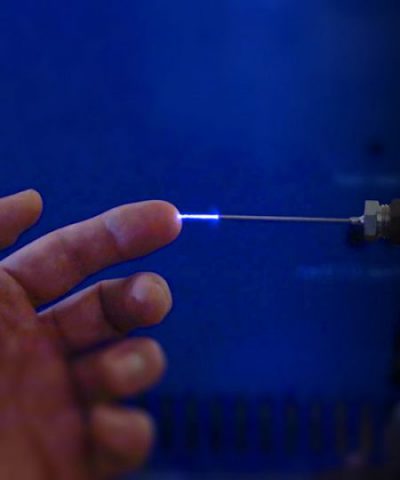Transient Plasma: Advantages and Applications
The Transient Plasma Papers | Volume 1, Part 1 — October 2019 | Advantages and Applications Series
Across a broad range of industries, plasma is a “secret sauce” of sorts. Plasma is one of the four fundamental states of matter, and it’s the most frequently forgotten or misunderstood of them all. However, the unique qualities of plasma make it an invaluable tool for a wide variety of applications.
Ultimately, plasma helps drive chemical reactions in very useful ways. In industrial and manufacturing applications, atmospheric-pressure plasma is used for several processes, including cleaning surfaces before they are painted, activating rubber for better adhesion, and applying thin-film coatings to glass or other substrates.
So, what are the attributes that make atmospheric-pressure plasma so useful in industrial environments? And what aspects of industrial atmospheric-pressure systems can be improved upon in terms of achieving greater efficiency, quality, and improved material properties? We’ll be exploring those topics in this first part of our three-part series.
Read the Other Installments:
Atmospheric-Pressure Plasma Explained
One of the things you may know about plasma is that stars are made out of it. The sun is a big ball of plasma. However, there are major differences between naturally occurring plasmas and the man-made atmospheric-pressure plasma systems used in industrial environments.
Plasma is ionized gas, a mixture of free-roaming electrons, positive ions, and neutral species that behaves far differently than standard gas. The naturally occurring plasma that makes up a star is extremely hot and in thermal equilibrium. In other words, the electrons and ions are at approximately the same temperature.
There are man-made thermal plasmas, such as the ones created by welding arcs. There are also man-made non-thermal plasmas, which are the ones often found in industrial environments. In these non-thermal plasmas, the electrons and ions are not in thermal equilibrium. This is by design: The energetic “hot” electrons can accomplish something useful, such as breaking a chemical bond, while the energy imparted to the “cool” ions and neutral species is minimized. Because the ions and neutrals account for nearly all of the mass of the plasma stream, keeping them cool avoids the extreme heat associated with thermal plasmas.

In atmospheric-pressure industrial plasma, energy is provided to the plasma by applying an electrical voltage that accelerates charged particles. The electrons are a few thousand times lighter than the ions, so they respond much more rapidly and zip around at speeds roughly 100x faster than the ions.
These electrons quickly gain enough energy to ionize additional particles, creating more free electrons to break bonds or provide the activation energy needed for desired chemical reactions. This is incredibly efficient, because the reaction rates driven by energetic electrons can be up to 1,000x faster than the ones driven by thermally heating the reactants.
Thus, these man-made non-thermal atmospheric plasmas are often used to drive efficient, fast chemical reactions. Such plasmas are used in applications such as ozone generation, cleaning, decontamination, surface activation to improve bonding, curing of coatings, and functional thin-film deposition.
The Trouble With Industrial Atmospheric-Pressure Plasma Systems
Today’s industrial plasma systems are typically driven by oscillating high voltages from 10s of Hz to GHz. When energy is applied on a time scale lasting longer than ~100 nanoseconds, the heavier ions have sufficient time to absorb some of the energy and play a more active role in the discharge.

When ions and neutral species begin to heat up, thermal instabilities in the plasma can become a problem. That’s when your nice, gently glowing plasma starts to look more like a chaotic cluster of lightning bolts. These instabilities can lead to an arc or a spark, which can make plasma treatment highly non-uniform and damaging to sensitive substrates or processes.
As a result, industrial plasma systems driven by long pulses of steady or oscillating voltages must operate in an incredibly narrow window: The plasma must be given sufficient energy to drive the desired chemistry, but not enough energy to create a potentially unstable thermal state. When operating at atmospheric pressure, this delicate balance must be carefully controlled to avoid the transition to a higher temperature, unstable thermal plasma.
Transient Plasma: Striking A Delicate Balance
Transient plasma is characterized by electrons that rapidly gain energy from extremely short and precisely controlled high-voltage pulses. In a transient plasma system, electrons perform the same useful functions as those in an industrial atmospheric-pressure plasma system, but with additional advantages in terms of efficiency and versatility.
Due to the extremely short and intense pulses in a transient plasma system, the ions and neutral species remain consistently cool; they simply don’t have time to absorb the energy that makes them unstable. Transient plasma systems eliminate the risks of arcing and thermal instability, enabling versatile operation over a wide range of pulse amplitudes, pulse repetition rates, and gas-flow rates.
As such, transient plasma systems can be used to enable a wider variety of applications as compared to conventional industrial atmospheric-pressure plasma systems.


